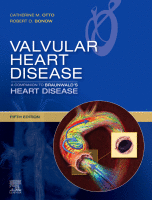Physical Address
304 North Cardinal St.
Dorchester Center, MA 02124

Key points The mitral valve is a complex, three-dimensional assembly of independent anatomic components, including the annulus, leaflets and commissures, chordae tendineae, papillary muscles, and left ventricle. Abnormalities (lesions with etiologic implications) in any of these components may cause alteration…

Key points Grading of mitral regurgitation (MR) severity by echocardiography should not be based on visual inspection of the color Doppler MR jet, but rather on integration of multiple qualitative and quantitative parameters. Secondary MR is dynamic, changing during systole…

Key points The estimated prevalence of mitral valve prolapse (MVP) for the general population is 2.4%. The term mitral valve prolapse refers to leaflet prolapse resulting from an elongated chorda and/or leaflet. It is usually diagnosed with the use of…

Key points Although the incidence of rheumatic heart diseases has decreased, mitral stenosis (MS) remains prevalent in developed countries. It is common and underdiagnosed in developing countries. Calcific MS is the consequence of extensive mitral annular calcification, the prevalence of…

Key points Transthoracic echocardiography (TTE) provides an accurate diagnosis of the cause of mitral regurgitation (MR) in most patients, although three-dimensional transesophageal imaging (TEE) often is needed for decisions about timing and type of intervention. Primary MR is caused by…

Key points Aortic valve replacement (AVR) has become increasingly safe even though an older population of patients is now being treated, with the best outcomes achieved at high-volume centers. Complete primary median sternotomy is the standard approach for aortic valve…

Key points Accurate annular sizing is critical for valve selection and minimizing complications during the performance of transcatheter aortic valve replacement (TAVR). Electrocardiogram (ECG)-gated computed tomographic (CT) angiography before TAVR is an integral part of the preprocedural evaluation of the…

Key points The prognosis for patients with symptoms due to severe valvular aortic stenosis treated medically is poor, with death rates as high as 51% at 1 year and 68% at 2 years for a series of patients at very…

Key points The bicuspid aortic valve (BAV) is the most common congenital heart condition, affecting approximately 1% of the population. Familial BAV occurs in 9% to 10% of first-degree relatives. Familial aortic aneurysm with or without BAV may occur in…

Key points Aortic regurgitation (AR) may be caused by abnormalities of the aortic leaflets, aortic root, or ascending aorta. Evaluation of AR should include valve morphology, regurgitation mechanism, and severity and aortic dilation assessment. Color Doppler proximal jet width with…